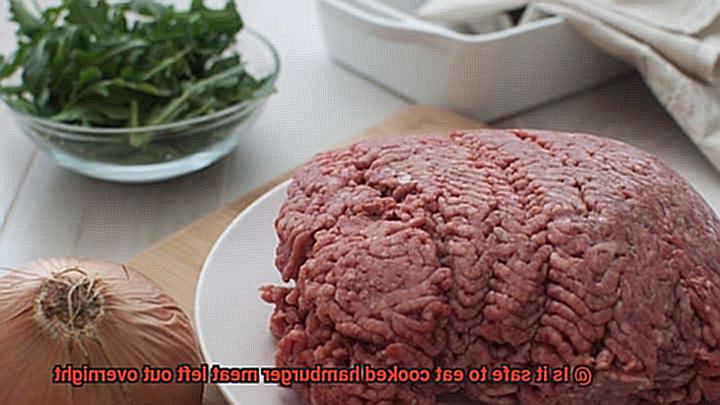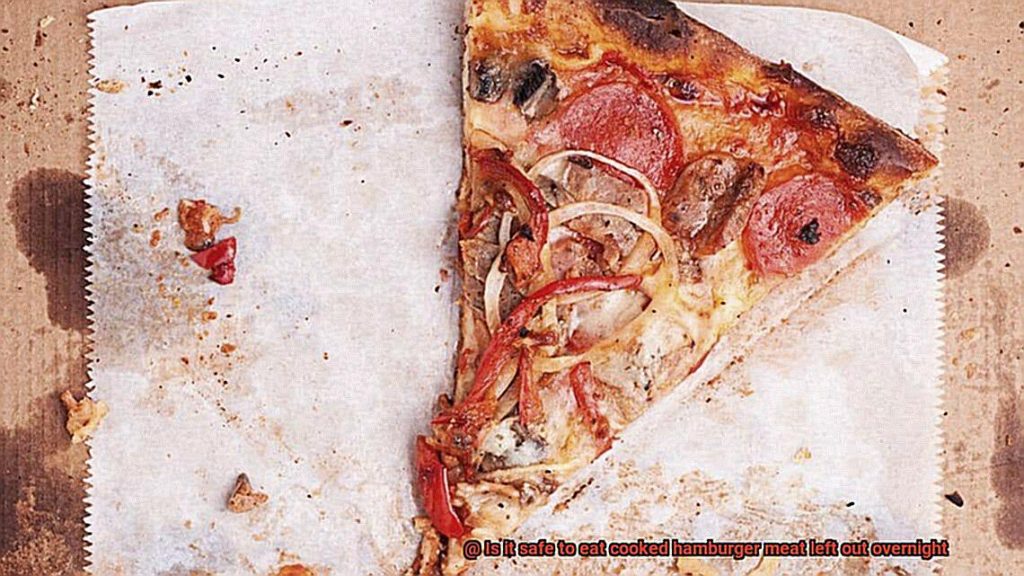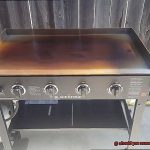Do you crave a delicious, juicy hamburger after a long day? Whether you prefer yours grilled to perfection or smothered in toppings, hamburgers are a classic American comfort food. But what happens when you forget to put away your leftover cooked hamburger meat at night? Can you still safely enjoy it the next day?
As an expert in the food industry, I’ve delved into the risks and safety measures of consuming cooked hamburger meat that’s been left out overnight. And let me tell you, the answer isn’t straightforward.
In this blog post, I’ll break down everything you need to know about eating cooked hamburger meat left out overnight. From the dangers of bacterial growth and foodborne illness to the importance of temperature control, I’ll cover it all. Plus, I’ll share tips on how to avoid getting sick from improperly stored leftovers.
So if you’re wondering whether that leftover burger in your fridge is still safe to eat, keep reading. You won’t want to miss this essential guide on the do’s and don’ts of consuming cooked hamburger meat left out overnight.
Contents
What is the “Danger Zone”?
This means that any perishable food item, including poultry, seafood, dairy products, and cooked vegetables, can become unsafe to eat if left in this temperature range for too long.
Cooked hamburger meat left out overnight falls within the “Danger Zone” temperature range. Harmful bacteria like E. coli and Salmonella can grow rapidly in cooked hamburger meat that has been left at room temperature for too long, even if it was cooked to a high enough temperature (160°F). This highlights the importance of proper food storage and handling to ensure your safety.
To prevent the growth of harmful bacteria, it is crucial to keep hot foods hot (above 140°F or 60°C) and cold foods cold (below 40°F or 4°C). This means that leftovers should be refrigerated within two hours of cooking and should not be left at room temperature for more than two hours. Additionally, it’s important to note that the “Danger Zone” is not just limited to cooked hamburger meat – any perishable food item can become unsafe to eat if left in this temperature range for too long.
What are the Potential Risks of Eating Cooked Hamburger Meat Left Out Overnight?
However, leaving cooked hamburger meat out overnight can lead to significant health risks that you certainly wouldn’t want to bite into.
The longer cooked meat sits out at room temperature, the higher the chances it will be contaminated with harmful bacteria such as E. coli and Salmonella. These bacteria thrive in temperatures between 40°F and 140°F, otherwise known as the “danger zone.” If left out for too long, cooked hamburger meat can quickly enter this danger zone and become a breeding ground for bacteria.
Another risk associated with eating leftover hamburger meat is the potential for toxins to develop. Even if your meat looks and smells fine, it may have already begun to break down and release harmful toxins that can cause food poisoning. These toxins can be particularly dangerous for young children, pregnant women, and those with weakened immune systems.
To avoid these risks, it’s crucial to follow proper food safety guidelines. Here are some tips:
- Refrigerate leftovers within two hours of cooking.
- Keep hot foods hot (above 140°F) and cold foods cold (below 40°F).
- Don’t let any perishable food item sit in the danger zone for too long.
- When in doubt, throw it out.
Factors that Can Affect the Safety of Cooked Hamburger Meat Left Out Overnight

Let’s dive into the factors that can affect the safety of cooked hamburger meat left out overnight.
Temperature is a crucial factor that affects the safety of cooked hamburger meat. Bacteria thrive in warm temperatures, and when the meat is left out at room temperature for too long, it creates the perfect breeding ground for bacterial growth. Therefore, it’s essential to keep cooked meat above 140°F or below 40°F to prevent bacterial growth.
Duration is another critical factor to consider. The longer the meat is left out, the higher the risk of bacterial growth. If the cooked hamburger meat is left out for more than two hours, it’s best to discard it to avoid foodborne illnesses. If the temperature is above 90°F, then the safe duration reduces to one hour.
The type of storage container used can also play a vital role in its safety. If the container used is not airtight, it can lead to contamination from other sources like insects, dust, or other microorganisms. Using a sealed container or wrapping the meat tightly with plastic can help prevent contamination and ensure its safety.
Lastly, how well the hamburger meat was cooked before being left out can also affect its safety. Undercooked meat can contain harmful bacteria like E.coli and Salmonella that can cause foodborne illnesses. Therefore, it’s vital to ensure that the hamburger meat is thoroughly cooked before consuming it.
How to Store Cooked Hamburgers Properly
To avoid wasting food and risking foodborne illness, it’s important to know how to store cooked hamburgers properly. Let’s take a closer look at the steps you should follow.
Cool Down First
Before storing cooked hamburgers, it’s crucial to let them cool down first. Leaving them out at room temperature for too long can increase the risk of bacterial growth. Allow the hamburgers to cool down at room temperature for no more than two hours.
Airtight Container
Once the hamburgers have cooled down, place them in an airtight container or wrap them tightly in plastic wrap or aluminum foil. This will help prevent exposure to air and moisture, which can lead to spoilage. Make sure the container is clean and dry before placing the hamburgers inside.
Label and Date
Labeling and dating your containers is essential to keep track of when they were prepared and stored. This will help you avoid consuming food that has been sitting in your fridge or freezer for too long, which can be harmful.
Refrigerate or Freeze
If you plan on eating your hamburgers within the next four days, store them in the refrigerator. If you’re planning on keeping them for longer than that, it’s best to freeze them instead. Hamburgers can be frozen for up to three months. When freezing hamburgers, make sure to remove as much air as possible from the container or freezer bag to avoid freezer burn.
Reheat Properly
When reheating your hamburgers, make sure that they are heated to an internal temperature of 165°F (74°C) to kill any bacteria that may have grown during storage. You can reheat hamburgers in the oven, microwave, or on the stovetop. Never reheat cooked hamburgers more than once as this increases the risk of bacterial growth.
Reheating Cooked Hamburgers
Reheating cooked hamburgers can be a great way to enjoy them again, but it’s important to do it safely to avoid any potential health risks. As an expert in this field, I’m here to share some important safety guidelines that you should keep in mind.
First and foremost, ensuring that the hamburger has been cooked to the correct internal temperature of 160°F (71°C) before refrigeration or freezing is crucial. This will help to minimize the growth of harmful bacteria that can cause foodborne illnesses. It’s important to remember that if you’re unsure whether your hamburger was cooked to the appropriate temperature, it’s best to avoid reheating it altogether.
If you have leftover hamburgers that have been left out overnight, it’s generally not recommended to reheat them. Bacteria can multiply rapidly at room temperature, and reheating may not destroy all of these harmful microorganisms. Reheating meat multiple times can also increase the risk of bacterial growth and contamination.
However, if you’re willing to take the necessary precautions, reheating leftover hamburgers is possible. The best method is to use a microwave or oven to heat the hamburger thoroughly until it reaches an internal temperature of 165°F (74°C). This will help to kill any bacteria that may have grown on the meat while it was left out.
To ensure safe reheating, handle the hamburger carefully and avoid cross-contamination with other foods. Use clean utensils and plates, and wash your hands thoroughly before and after handling the meat. Remember that proper food safety guidelines are essential when reheating cooked hamburgers.
The Benefits of Refrigeration and Freezing for Food Safety
Then it’s essential to know how to keep your meat fresh and safe to eat. That’s where refrigeration and freezing come in. These two methods are among the most effective ways to ensure food safety.
Refrigeration is crucial in preventing the growth of harmful bacteria that can cause food poisoning. Bacteria multiply rapidly at room temperature, making it necessary to refrigerate cooked hamburger meat as soon as possible after cooking. The ideal temperature range for refrigeration is between 35°F and 40°F (1.6°C to 4.4°C). At this range, bacterial growth is significantly slowed down, reducing the risk of foodborne illness. Plus, refrigerating your cooked hamburger meat helps preserve its quality by keeping it moist and flavorful.
But what about freezing? Freezing is another effective way to prevent bacterial growth and extend the shelf life of your cooked hamburger meat. When stored correctly in a freezer at 0°F (-18°C) or below, cooked hamburger meat can remain safe for several months. However, it’s important to note that freezing doesn’t kill bacteria; it only puts them into a dormant state. Therefore, proper handling and cooking of frozen hamburger meat are vital before consuming.
In addition to preventing bacterial growth, refrigeration and freezing help preserve the quality of your cooked hamburger meat. When left at room temperature for too long, meat can become dry and tough. By promptly refrigerating or freezing your cooked hamburger meat, its texture and flavor will be preserved, and it will still be enjoyable to eat even after being stored for an extended period.
Practical Tips for Cooking Hamburgers Safely
Cooking hamburgers is a beloved pastime that can be enjoyed year-round, but it’s important to keep safety in mind. Here are five practical tips for cooking hamburgers safely:
Thoroughly cook the meat
Cook the hamburger meat to an internal temperature of 160°F (71°C) to kill any harmful bacteria that may be present. Use a meat thermometer to ensure that the temperature is reached throughout the patty.
Avoid cross-contamination
Keep raw meat separate from other foods and use separate cutting boards and utensils for handling raw meat. Wash your hands thoroughly before and after handling raw meat to prevent the spread of bacteria.
Preheat the grill
Before adding the meat, preheat the grill to a high temperature. This will help ensure that the hamburgers cook evenly and quickly, reducing the risk of bacteria growth.
Flip once
Resist the urge to flip burgers multiple times as this can cause the juices to escape and increase the risk of bacteria growth. Flip the patty only once when necessary and use a spatula to avoid piercing the meat.
Properly store cooked hamburgers
Refrigerate cooked hamburger meat within two hours of cooking to prevent bacteria growth. Leaving cooked hamburgers out at room temperature increases the risk of food poisoning.
Common Misconceptions about Food Safety
One of the most dangerous misconceptions is that cooked hamburger meat left out overnight is safe to eat. This is not only false but also puts you at risk of serious health problems.
Many people believe that cooking meat kills all bacteria and makes it safe to eat. While cooking does kill most bacteria, it doesn’t necessarily remove all of them. Bacteria can multiply quickly at room temperature, leading to a dangerous buildup of harmful pathogens in the meat. This is why storing cooked meat in the refrigerator within two hours of cooking and reheating it to an internal temperature of 165°F before consuming is crucial.
Another misconception is that if the meat looks and smells fine, it must be safe to eat. Unfortunately, this isn’t always the case. Harmful bacteria like E. coli and Salmonella may not have any visible signs or odors, making it impossible to detect them with our senses alone.
It’s also important to note that some people are more vulnerable to foodborne illnesses than others. Children, pregnant women, older adults, and individuals with weakened immune systems are at higher risk of experiencing severe symptoms from consuming contaminated food.
To ensure proper food safety, follow these guidelines:
- Cook meat thoroughly to kill harmful bacteria
- Use separate cutting boards and utensils for raw and cooked meats to avoid cross-contamination
- Store cooked meat in the refrigerator within two hours of cooking
- Reheat cooked meat to an internal temperature of 165°F before consuming
- Don’t rely on appearance or smell alone to determine the safety of your food
RQBOJriKXSA” >
Conclusion
In the end, eating cooked hamburger meat that has been left out overnight is a risky move. The presence of harmful bacteria like E. coli and Salmonella can quickly multiply in cooked hamburger meat that has been at room temperature for too long, even if it was cooked to a high enough temperature (160°F). This underscores the importance of proper food storage and handling to ensure your safety.
To prevent the growth of harmful bacteria, it’s essential to keep hot foods hot (above 140°F or 60°C) and cold foods cold (below 40°F or 4°C). However, other factors such as duration, type of storage container used, and how well the hamburger meat was cooked before being left out can also impact its safety.
The key to storing cooked hamburgers properly is to cool them down first, place them in an airtight container or wrap them tightly in plastic wrap or aluminum foil, label and date the containers, refrigerate or freeze them accordingly and reheat them correctly. Refrigeration and freezing are among the most effective ways to ensure food safety by preventing bacterial growth and preserving the quality of your cooked hamburger meat.
It’s crucial to follow practical tips for cooking hamburgers safely such as thoroughly cooking the meat, avoiding cross-contamination, preheating the grill, flipping once when necessary and properly storing cooked hamburgers. Don’t fall prey to common misconceptions about food safety such as assuming that cooking kills all bacteria or relying on appearance or smell alone to determine whether your food is safe.
By adhering to proper food safety guidelines, you can savor delicious hamburgers without any worries.






